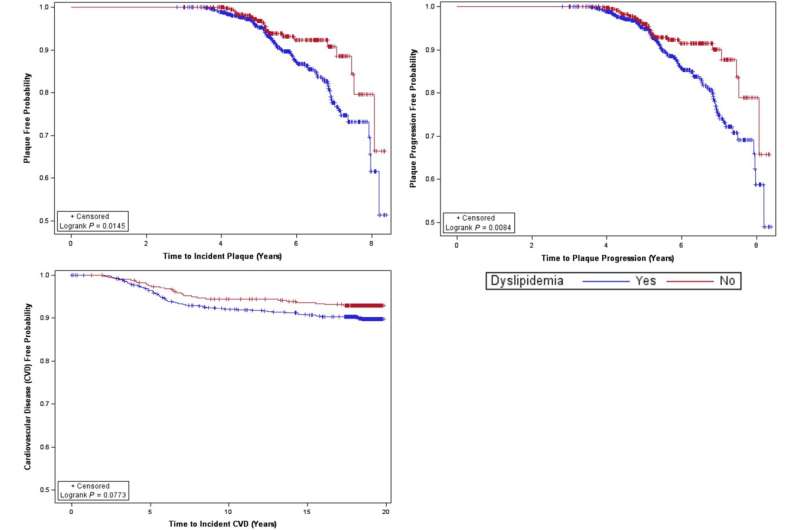This article has been reviewed according to Science X's editorial process and policies. Editors have highlighted the following attributes while ensuring the content's credibility:
fact-checked
peer-reviewed publication
trusted source
proofread
More than half of American Indian youth may have abnormal or high cholesterol

More than 70% of American Indian young adults aged 20–39 and 50% of American Indian teens have cholesterol levels or elevated fat in the blood that puts them at risk for cardiovascular disease, suggests a new study. In some cases, these levels—specifically high low-density lipoprotein (LDL) cholesterol, often thought of as "bad cholesterol"—were linked to plaque buildup and cardiovascular events, such as heart attack and stroke.
The findings, published in the Journal of the American Heart Association, came from a 19-year-review of the Strong Heart Family Study, part of the Strong Heart Study—the largest study of cardiovascular health outcomes and risk factors among American Indian adults.
Researchers followed more than 1,400 participants, ages 15–39, from a baseline examination taken 2001–2003 to follow-ups in 2006–2009 and 2020. At the beginning of the study, 55% of participants ages 15–19 had abnormal cholesterol levels, as did 74% of those ages 20–29, and 78% of those ages 30–39.
"We were surprised about the numbers, especially in adolescents," said Jessica A. Reese, Ph.D., an epidemiologist in the Center for American Indian Health Research at the University of Oklahoma Health Sciences Center, Oklahoma City.
"These findings show the importance of early screenings and interventions, especially for teens and young adults who may be more likely to have underlying cardiovascular risks, diabetes, or chronic liver disease."
The researchers defined a person's cholesterol as abnormal if they had either high total cholesterol; high LDL cholesterol or other types of "bad" cholesterol; moderately-high triglycerides; low HDL cholesterol, often thought of as "good cholesterol"; or if they had been prescribed cholesterol-lowering medication.
About 40% of study participants had high LDL levels (at least 100 mg/dL), while nearly 3% had very high levels (at least 160 mg/dL). However, less than 2% of participants with very high LDL cholesterol took cholesterol-lowering medication at the start of the study.
"This research supports efforts to identify ways, such as increased screenings and culturally relevant education, to improve heart health and support younger generations of Native Americans," said Mona Puggal, M.P.H., an epidemiologist in the Division of Cardiovascular Sciences at the National Heart, Lung, and Blood Institute (NHLBI), part of NIH.
Heart disease is twice as high in American Indian adults compared to the general U.S. population. Abnormal cholesterol levels seen among participants in the current study were also twice as high as abnormal levels seen in the general population of U.S. teens and young adults.
Researchers underscored the value of routine check-ins and screenings. All participants in this observational study were also notified about their lab work and imaging results after their physical exam and researchers encouraged them to take the results to their health care providers.
At the start of the study, 1,165 participants had ultrasounds of the carotid artery, an artery in the neck that carries blood from the heart to the brain. Approximately 61 (5%) showed signs of plaque or early plaque development. Plaque can prohibit blood flow to the heart or rupture when too much of it accumulates in an artery, and that can lead to a stroke or need for surgery.
About 5.5 years after the baseline measurements, 19 participants—about one-third of those with detectable plaque—had signs of their plaque getting worse. Among the 1,104 who did not have detectable plaque at the beginning, 109 (10%) had signs of it during the second check-in. Researchers linked high levels of LDL cholesterol, total cholesterol, and other non-HDL cholesterol to these outcomes.
By the end of the study, approximately 127 participants (9%) had experienced a heart attack, stroke, heart failure, or a related heart surgery or death. Participants who had diabetes and at least a few cardiovascular risks, such as having a large waistline, high blood sugar, high triglycerides, high blood pressure, or low levels of HDL cholesterol, were also more likely to have cardiovascular events.
To support early risk detection, researchers emphasized the importance of youth staying connected to health care providers.
"It's important for everyone to work with their physician to annually check their blood cholesterol and blood sugar, which can support a healthy life later on," said Ying Zhang, M.D., Ph.D., Director at the Center for American Indian Health Research at the University of Oklahoma Health Sciences Center. "It's also vital that annual care is coordinated as youth mature from seeing pediatricians to adult health care providers."
More information: Dyslipidemia in young American Indians: Strong Heart Family Study, Journal of the American Heart Association (2024). DOI: 10.1161/JAHA.123.031741



















